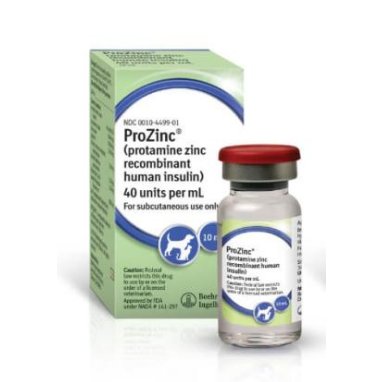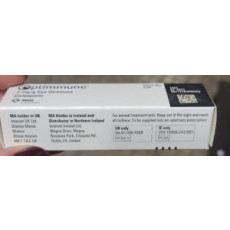ProZinc 40IU/ml POM-V
![]() Available
Available
Product Description
ProZinc - For the treatment of diabetes mellitus in cats and dogs to achieve reduction of hyperglycaemia and improvement of associated clinical signs.
Dosage and administration
Subcutaneous use.
If the animal owner is to administer the product, suitable training/advice should be provided by the prescribing veterinarian before using for the first time.
Dosage
The veterinarian should re-evaluate the animal at appropriate intervals and make adjustments to the treatment protocol, for instance dose and dosing regimen, until adequate glycaemic control has been attained.
Any dose adjustment (i.e. increase of dose) should be in general performed after several days (e.g. 1 week) since full action of insulin requires an equilibration phase. Dose reductions due to observed hypoglycaemia or suspected Somogyi effect (rebound hyperglycaemia) may be of 50% or higher (potentially including a temporary pause of insulin administration).
Once adequate glycaemic control is achieved intermittent glucose monitoring should be performed, especially when there is a change in clinical signs or diabetic remissionis is suspected, and further adjustments in the insulin dose might be necessary.
Cats:
The initial recommended dose is 0.2 to 0.4 IU insulin/kg bodyweight every 12 hours.
- For cats previously controlled on insulin, a higher starting dose up to 0.7 IU insulin/kg bodyweight may be appropriate.- Adjustments of insulin dose if required should usually be done between 0.5 to 1 IU insulin per injection.
Cats can develop diabetic remission, in which case sufficient endogenous insulin production will be regained and exogenous insulin dose will need to be adjusted or ceased.
Dogs:
General guidance:
Dosing should be individualised and based on the clinical presentation of each patient. To achieve optimal control of diabetes mellitus, dose adjustments should primarily be based on clinical signs. Blood parameters such as fructosamine, maximum blood glucose and decrease of blood glucose concentrations in blood glucose curves conducted over a sufficient period of time to determine a blood glucose nadir should be used as supporting tools.
Re-evaluation of clinical signs and laboratory parameters should be performed as recommended by the attending veterinarian.
Initiation
For initiation of treatment, the recommended dose is 0.5 to 1.0 IU insulin/kg bodyweight once daily every morning (approx. every 24 h).
For newly diagnosed diabetic dogs, a starting dose of 0.5 IU insulin/kg once daily is recommended.
Management
Adjustments of insulin dose on a once daily regimen, if required, should generally be done in a conservative and gradual manner, (e.g. up to 25% increase/decrease of the dose per injection).
If insufficient improvement in diabetic control is observed after an adequate dose adjustment period of 4 to 6 weeks on once daily treatment, the following options may be considered:
- Further adjustments of insulin dose on once daily treatment may be necessary; in particular if dogs undertake increased physical activity, have a change of their usual diet or during concomitant illness.
- Switching to twice daily dosing: In such cases, it is recommended to reduce the dose per injection by one third (e.g. 12 kg dog being treated once daily with 12 IU insulin/injection may be switched to 8 IU insulin/injection administered twice daily). The product should be administered in the morning and in the evening, approx. 12 hours apart. Further adjustments of insulin dose on twice daily treatment may be necessary.
Depending on the underlying cause (e.g. dioestrus-induced diabetes mellitus), dogs can develop diabetic remission, although more seldom than in cats. In those cases sufficient endogenous insulin production will be regained and the exogenous insulin dose will need to be adjusted or ceased.
Loyalty Scheme
Earn up to 66 loyalty points with this product.





Share
ProZinc 40IU/ml POM-V
Facebook Twitter Email Pinterest Telegram